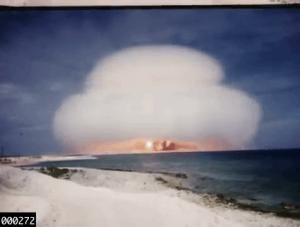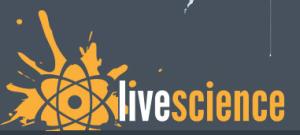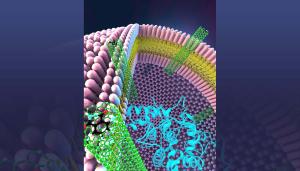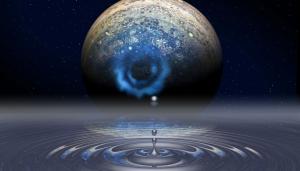LAB REPORT
Science and Technology Making Headlines
Oct. 6, 2017


Operation Hardtack was one of the many nuclear bomb tests undertaken in the Marshall Islands.
Bombs on film
Between 1945 and 1962, the Department of Energy conducted 210 atmospheric nuclear tests. Each test was captured by multiple cameras at around 2,400 frames per second -- an estimated 10,000 films overall. For decades, most of those films collected dust and began to decompose in high-security vaults scattered across the country.
Until last March. After spending several years hunting down the footage, weapons physicist Greg Spriggs and a team of physicists at Lawrence Livermore National Laboratory located about 6,500 of the films, and have since declassified about 750 of them.
One of the goals of the project was to ensure that today’s post-testing-era scientists who are using computer codes are working with the most accurate data. But Spriggs and his team got more than they bargained for when they took a closer look at the films. They discovered that much of the published data from the tests were incorrect -- sometimes off by as much as 20 percent to 30 percent. That meant that all the films would need to be reanalyzed.


A new project led by Lawrence Livermore aims to utilize distributed energy resources such as customer-generated solar power to enhance the electrical grid’s ability to recover from a blackout or cascading outage quickly in the event of a major disaster.
Feel the power
Researchers at Lawrence Livermore recently launched a new initiative aiming to utilize the benefits of distributed energy resources (DERs), such as customer-produced solar energy for restoration and recovery purposes after severe storms.
Led by LLNL researcher Emma Stewart and partners from the Los Alamos National Laboratory and the Pacific Northwest National Laboratory, the CleanstartDERMS project is one of seven projects funded by the Department of Energy’s Energy Grid Modernization Initiative through its Resilient Distribution Systems lab call.
Stewart said that the goal of the project will demonstrate the usability of DERs to maintain resiliency on the grid for large-scale events, noting that those resources would be used to form a dynamic microgrid that would form and evolve based on what it’s monitoring to bring power back faster to customers.


An artist’s depiction of the promise of carbon nanotube porins for desalination. The image depicts a stylized carbon nanotube pipe that delivers clean desalinated water from the ocean to a kitchen tap. Image by Ryan Chen/LLNL
No salt shall pass
A carbon nanotube (CNT) is a minuscule, straw-like structure made of carbon atoms. These tubes are extremely useful in a wide variety of electronic, magnetic and mechanical technologies. The diameters of these tubes are so tiny that they are measured in nanometers. (A nanometer is about 10,000 times smaller than a human hair.)
Nanotechnology is being applied to the quest to turn seawater into drinking water. In a new study, scientists at Lawrence Livermore National Laboratory have developed a carbon nanotube process that can take the salt out of seawater far more efficiently than traditional technologies.
At LLNL, the scientists mimicked the way biological membranes are structured: essentially a matrix with pores inside the membrane. They used nanotubes that were particularly small -- more than 50,000 times thinner than a human hair. These tiny nanotubes allow for a very high flux of water but are so narrow that only one water molecule can pass through the tube at a time. And most importantly, the salt ions are too big to fit through the tube.
The researchers think the new discovery has important implications for the next generation of both water purification processes and high-flux membrane technologies.


Lawrence Livermore researchers have reported the synthesis of 3D-printed transparent glass components using a "slurry" of silica particles extruded through a direct-ink writing process. From left: LLNL chemical engineer and project lead Rebecca Dylla-Spears and LLNL materials engineer Du Nguyen.
Through the looking glass
Scientists at Lawrence Livermore have for the first time 3D-printed transparent glass at room temperature. This new 3D printing method can offer not only transparent glass but glass structures with composition gradients, something that has been impossible with conventional manufacturing methods.
Being able to 3D print glass is ideal for laboratories like LLNL, which deal with high-power lasers that require a large amount of optics. In additiont, being able to just print transparent glass where the refractive index can be altered could make a trip to the optician a whole lot easier in the future.
Existing 3D printing methods just don’t quite cut it -- the glass is opaque, porous and non-uniform structures exist within the glass. Therefore, current 3D-printed glass is just not as good as glass made by conventional methods. With the new technique discovered by LLNL scientists, glass that is "transparent, free-form and 3D with sub-millimeter features" is produced.


A hydrogenation mechanism that directly forms magnesium borohydride avoids issues known to inhibit the speed at which a hydrogen vehicle can be refueled.
Hydrogen storage steps on the gas
Scientists at the Lawrence Livermore are exploring ways to use an inexpensive and layered superconductor compound to efficiently store hydrogen.
They have already discovered the key mechanism used by magnesium diboride (MgB2) to absorb hydrogen and the reaction pathway that converts MgB2 to its highest hydrogen capacity form, magnesium borohydride (Mg(BH4)2). Mg(BH4)2 is a particularly promising hydrogen storage material because of its high hydrogen content and attractive thermodynamics.
Storing hydrogen is critical for hydrogen-fueled transportation as well as grid resiliency, energy storage and the use of diverse domestic energy sources, including hydrogen, to reduce oil dependency.





